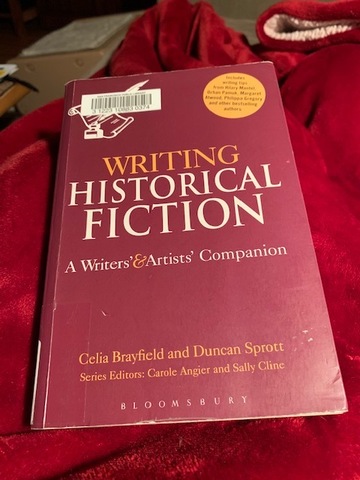
Writing Historical Fiction: a Writers and Artists Companion by Celia Brayfield and Duncan Sprott, (Bloomsbury) 2014 is an interesting book: part how-to manual, part history of the genre, part fascinating opinions by best-selling and best-known authors of the historical fiction genre, with a reasonable amount of space spent on the unique challenges of writing about women in the past. Here's what struck me about the book:
How Women Are Written and How to Correct That
The headless woman (shown from the neck down) "is a visual cliché on the covers of historical novels…" (pg. 50) but the trivialization and downright erasure of women in history goes much further.
"Women, especially women not from a ruling class, are the largest group to have been marginalized, or even deleted from the record, in historical terms. So the first challenges [in writing about women in history] will not only be a lack of records to research, but a consensual understanding that is thoughtlessly misogynistic. Royal blood has been no protection against the sexism of generations of historians and dramatists, who even today celebrate queens in European history as victims rather than rulers. Cleopatra and Boudicca are famous for their deaths rather than their lives; and Mary, Queen of Scots has been celebrated for her victimhood, while her incompetence was overlooked until Jenny Wormald published Mary Queen of Scots: A Study in Failure in 1991. If a female ruler was unquestionably successful, historians and writers alike have argued that she was in some way deficient as a woman, claiming that Elizabeth I's approach to her rule was founded on romantic disappointment, or holding up Queen Victoria as a bad mother to her 13 children. "Page 52
"It is hard to find unbiased records, to find any records at all in many cases, and hard to combat enduring portraits of women as impotent victims. Many writers are concerned to reimagine the events of the past with women as active protagonists but encounter these forces as an undertow that is constantly dragging their imagination towards the stereotypes." Page 54 "For a writer, especially a writer who wants to respond to the challenges of being a woman, there is an uncomfortable sense that archetype is working against you and that the industry is more willing to back the archetype than innovation." Page 102
"A writer who wants to create a heroine in a work of historical fiction needs to consider that:
- historical records may be meager and biased
- the consensual image of a prominent female figure will almost certainly be at odds with the historical record, and also with contemporary expectations of the woman
- powerful stereotypes will distort your imaginative process
- you will need to balance historical accuracy and current understanding of a woman's role and behavior. " Page 57
The Difference Between History and HisFict: The Story of the Heart
At the same time, though, Hilary Mantel reminds us that you "mustn't express ideas [the characters] couldn't have had, and feelings they wouldn't have had. They did not draw metaphors from a scientific worldview but from a religious one. They weren't democrats. They weren't feminists. The past doesn't respect the sensitivities of the present. The reader should be braced by the shock of the old; or why write about the past at all?" Hillary Mantel, page 136
"Edmund White has written, "The job of the enlightened historical novelist is to show that the sun never sets twice on the same human sentiments. Each period has its own character, and no sentiment is natural, uninflected by the prevailing social forces. White says that if historical fiction is to be given the same weight we admire in the best novels of modern life, we must kick out the picturesque and trace out the consequences of moral choices – but only those that were genuine options at the time. We must forget modern ideas of fairness and of sexual erotic appeal, and happy marriages between sharing and loving partners of the same age and station; we must dig up the buried shapes of long-forgotten values and social arrangements. He says, "the new historical novel must not sanitize the past for contemporary tastes." We want to know what it was really like, and it is not difficult to reconstruct how it was." Page 28
Other Pearls of Wisdom
- "Novels arise out of the shortcomings of history "– Novalis (1772-1801)
- On research: "First build your iceberg, then use the tip of it. Some icebergs are bigger than others." Page 224
- "Margaret Atwood has said, "all novels are historical novels – the present never really exists in fiction." Page 18
- "The fact is that we know far too much about the present.... The paradox is that the past, about which we know much less, is more manageable: there's less information to plow through, it's easier to research, easier to grasp. " Page 18
- The very best historical fiction presents to us a truth of the past that is not the truth of the history books but a bigger and more important truth – the truth of the heart.
- "To paraphrase Edmund White (who is talking about autobiography): History shows us formal long-shot panoramas of crowds – especially armies – historical fiction gives us the individual in all his [or her, sic] glowing detail." Page 18
"So we beat on, boats against the current, born back ceaselessly into the past." (F. Scott Fitzgerald The Great Gatsby. Page 29) calling on Clio, the muse of history. Page 35